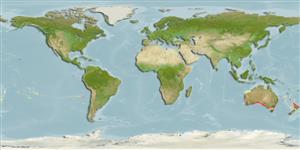Environment: milieu / climate zone / depth range / distribution range
Ecologia
marino associati a barriera corallina; distribuzione batimetrica 0 - 400 m (Ref. 58302), usually 15 - 60 m (Ref. 30464). Subtropical; 19°S - 42°S, 114°E - 76°W
Eastern and western South Pacific: Exact distribution unknown because of taxonomic uncertainties.
Size / Peso / Age
Maturity: Lm ? range ? - ? cm
Max length : 55.0 cm FL maschio/sesso non determinato; (Ref. 89444); common length : 30.0 cm TL maschio/sesso non determinato; (Ref. 30464)
Spine dorsali (totale): 10; Raggi dorsali molli (totale): 19-21; Spine anali 3; Raggi anali molli: 7 - 9; Vertebre: 26. Lateral line scales of individuals in the eastern Pacific is 58-65, in western Pacific 61-71 (Ref. 120532). Monochromatic orange-red or with black spots on the dorsal fin (Ref. 43805). Congruent rays of the dorsal fin and a caudal fin with a deep median notch in both sexes (Ref. 43805). Preopercle serrate, but without antrorse spines (Ref. 40817).
Occurs inshore near reefs (Ref. 7300). Benthopelagic and benthic (Ref. 58302). Feeds on plankton and small nekton. Occasionally caught on small hooks when fishing in midwater without sinker and make excellent eating (Ref. 30464). Its abundant gillrakers and stomach contents characterize it as an opportunistic pelagic polyphagic-zooplanktivorous predator (Rojas et al. 1998a, c) (Ref. 89357).
Life cycle and mating behavior
Maturità | Riproduzione | Deposizione | Uova | Fecundity | Larve
Paxton, J.R., D.F. Hoese, G.R. Allen and J.E. Hanley, 1989. Pisces. Petromyzontidae to Carangidae. Zoological Catalogue of Australia, Vol. 7. Australian Government Publishing Service, Canberra, 665 p. (Ref. 7300)
IUCN Red List Status (Ref. 130435)
Threat to humans
Harmless
Human uses
Informazioni ulteriori
Nomi ComuniSinonimiMetabolismoPredatoriEcotossicologiaRiproduzioneMaturitàDeposizioneSpawning aggregationFecundityUovaEgg development
BibliografiaAcquacolturaProfilo di acquacolturaVarietàGeneticaElectrophoresesEreditarietàMalattieElaborazioneNutrientsMass conversion
CollaboratoriImmaginiStamps, Coins Misc.SuoniCiguateraVelocitàModalità di nuotoArea branchialeOtolithsCervelliVista
Strumenti
Special reports
Download XML
Fonti Internet
Estimates based on models
Preferred temperature (Ref.
123201): 16 - 23.2, mean 17.9 °C (based on 250 cells).
Phylogenetic diversity index (Ref.
82804): PD
50 = 0.6250 [Uniqueness, from 0.5 = low to 2.0 = high].
Trophic level (Ref.
69278): 3.9 ±0.63 se; based on food items.
Resilienza (Ref.
120179): Basso, tempo minimo di raddoppiamento della popolazione 4.5 - 14 anni (Preliminary K or Fecundity.).
Fishing Vulnerability (Ref.
59153): Moderate vulnerability (44 of 100).
Nutrients (Ref.
124155): Calcium = 20.5 [11.7, 42.9] mg/100g; Iron = 0.581 [0.295, 1.033] mg/100g; Protein = 19.1 [17.3, 20.8] %; Omega3 = 0.268 [0.155, 0.461] g/100g; Selenium = 24.1 [12.5, 46.4] μg/100g; VitaminA = 64 [22, 230] μg/100g; Zinc = 0.568 [0.374, 0.872] mg/100g (wet weight);
